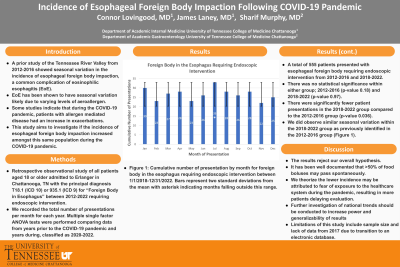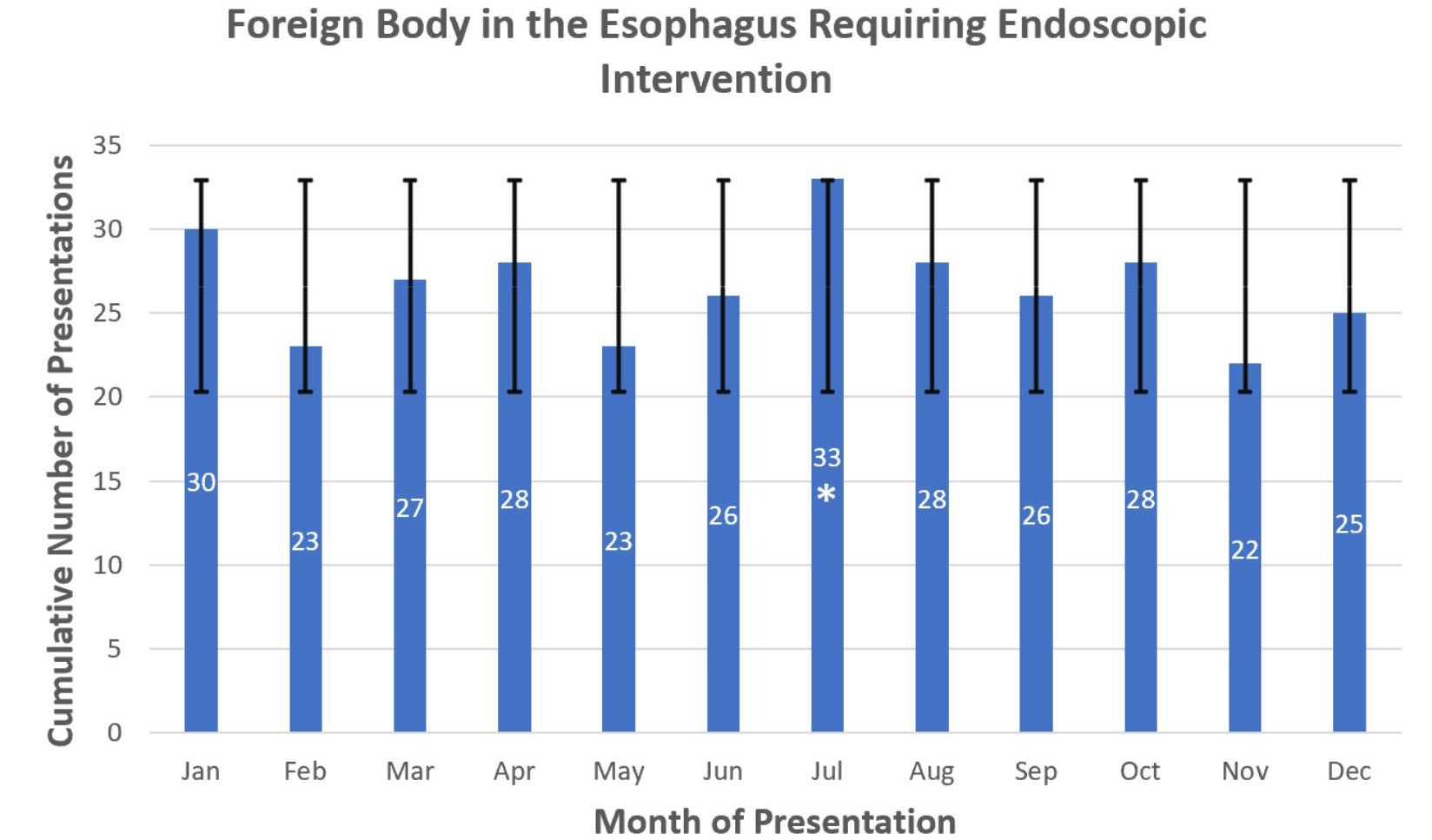Tuesday Poster Session
Category: Esophagus
P3935 - Incidence of Esophageal Foreign Body Impaction Following COVID-19 Pandemic
Tuesday, October 29, 2024
10:30 AM - 4:00 PM ET
Location: Exhibit Hall E

Has Audio
- CL
Connor Lovingood, MD
University of Tennessee Health Science Center
Chattanooga, TN
Presenting Author(s)
Connor Lovingood, MD, James Laney, MD, Sharif Murphy, MD
University of Tennessee Health Science Center, Chattanooga, TN
Introduction: A prior study reflective of the Tennessee River Valley from 2012-2016 showed seasonal variation in the incidence of esophageal foreign body impaction, a common complication of eosinophilic esophagitis (EoE). EoE has been shown to have seasonal variation likely due to varying levels of aeroallergen. Some studies have indicated that during the COVID-19 pandemic, patients with allergen mediated disease had an increase in exacerbations. With aeroallergens implicated in the progression of EoE, this study aims to investigate if the incidence of esophageal foreign body impaction increased amongst this same population during the COVID-19 pandemic.
Methods: Retrospective observational study of all patients aged 18 or older admitted to an academic tertiary referral hospital in Chattanooga TN, with the principal diagnosis T18.1 (ICD 10) or 935.1 (ICD 9) for “Foreign Body in Esophagus” between 2012-2016 and again between 2018-2022 requiring endoscopic intervention. We recorded the total number of presentations per month for each year. Multiple single factor ANOVA tests were performed comparing data from years prior to the COVID-19 pandemic and years during, classified as 2020-2022.
Results: A total of 555 patients presented with esophageal foreign body requiring endoscopic intervention from 2012-2016 and 2018-2022. There was no statistical significance within either group; 2012-2016 (p-value 0.18) and 2018-2022 (p-value 0.97). There were significantly fewer patient presentations in the 2018-2022 group compared to the 2012-2016 group (p-value 0.036). We did observe similar seasonal variation within the 2018-2022 group as previously identified in the 2012-2016 group (Figure 1).
Discussion: The results reject our overall hypothesis. It has been well documented that >50% of food boluses may pass spontaneously. We theorize the lower incidence may be attributed to fear of exposure to the healthcare system during the pandemic, resulting in more patients delaying evaluation. It is possible that many food boluses spontaneously resolved. Thus far, there have been no reports on decreasing trends of EoE within the U.S. Further investigation of potential decreased incidence of esophageal impaction amongst those with EoE will need to be performed across more diverse national geography to explore any national trends. Limitations of this study include sample size and lack of data from 2017 due to transition to an electronic database.

Disclosures:
Connor Lovingood, MD, James Laney, MD, Sharif Murphy, MD. P3935 - Incidence of Esophageal Foreign Body Impaction Following COVID-19 Pandemic, ACG 2024 Annual Scientific Meeting Abstracts. Philadelphia, PA: American College of Gastroenterology.
University of Tennessee Health Science Center, Chattanooga, TN
Introduction: A prior study reflective of the Tennessee River Valley from 2012-2016 showed seasonal variation in the incidence of esophageal foreign body impaction, a common complication of eosinophilic esophagitis (EoE). EoE has been shown to have seasonal variation likely due to varying levels of aeroallergen. Some studies have indicated that during the COVID-19 pandemic, patients with allergen mediated disease had an increase in exacerbations. With aeroallergens implicated in the progression of EoE, this study aims to investigate if the incidence of esophageal foreign body impaction increased amongst this same population during the COVID-19 pandemic.
Methods: Retrospective observational study of all patients aged 18 or older admitted to an academic tertiary referral hospital in Chattanooga TN, with the principal diagnosis T18.1 (ICD 10) or 935.1 (ICD 9) for “Foreign Body in Esophagus” between 2012-2016 and again between 2018-2022 requiring endoscopic intervention. We recorded the total number of presentations per month for each year. Multiple single factor ANOVA tests were performed comparing data from years prior to the COVID-19 pandemic and years during, classified as 2020-2022.
Results: A total of 555 patients presented with esophageal foreign body requiring endoscopic intervention from 2012-2016 and 2018-2022. There was no statistical significance within either group; 2012-2016 (p-value 0.18) and 2018-2022 (p-value 0.97). There were significantly fewer patient presentations in the 2018-2022 group compared to the 2012-2016 group (p-value 0.036). We did observe similar seasonal variation within the 2018-2022 group as previously identified in the 2012-2016 group (Figure 1).
Discussion: The results reject our overall hypothesis. It has been well documented that >50% of food boluses may pass spontaneously. We theorize the lower incidence may be attributed to fear of exposure to the healthcare system during the pandemic, resulting in more patients delaying evaluation. It is possible that many food boluses spontaneously resolved. Thus far, there have been no reports on decreasing trends of EoE within the U.S. Further investigation of potential decreased incidence of esophageal impaction amongst those with EoE will need to be performed across more diverse national geography to explore any national trends. Limitations of this study include sample size and lack of data from 2017 due to transition to an electronic database.

Figure: Figure 1: Cumulative number of presentation by month for foreign body in the esophagus requiring endoscopic intervention between 1/1/2018-12/31/2022. Bars represent two standard deviations from the mean with asterisk indicating months falling outside this range.
Disclosures:
Connor Lovingood indicated no relevant financial relationships.
James Laney indicated no relevant financial relationships.
Sharif Murphy indicated no relevant financial relationships.
Connor Lovingood, MD, James Laney, MD, Sharif Murphy, MD. P3935 - Incidence of Esophageal Foreign Body Impaction Following COVID-19 Pandemic, ACG 2024 Annual Scientific Meeting Abstracts. Philadelphia, PA: American College of Gastroenterology.
